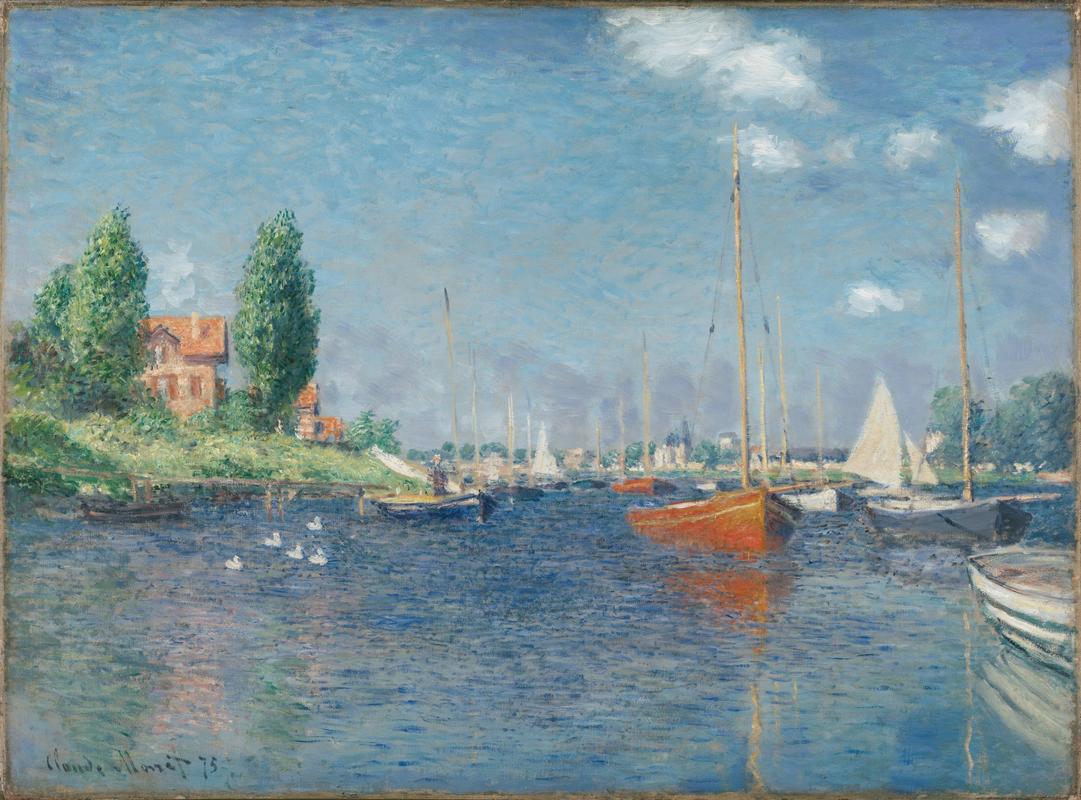More about Red Boats, Argenteuil
- All
- Info
- Shop

Contributor
The Impressionists were kind of the preppy bros of painting in their heyday.
They hung around country houses, drank absinthe and subscribed to a strict, if idealistic idea of what life was like. They had an image of what the world should look like and they stuck to that image, completely ignoring the soot and disease their bourgeois dads (indirectly) puked into the air via facilitating coal based marine trade. This one by Mr. Water Lily himself is no exception. But underneath the intentionally quaint scene and soft brushstrokes is a darker history that makes an otherwise standard mid-career Monet into a blood diamond.
Of course, you can’t tell just by looking at a diamond that it was polished with human lives.
On the surface we have some too-typical impressionism. Claude did some heavy photoshopping, cutting factory smoke stacks to emphasize the pastoral dreaminess. So rural, you can even rent a dinghy from the fellow in the middle-left and drift around with your honey like in the good old days.
Monet moved his family to Argenteuil in 1871, a Vineyard Vines dream-town where rowing and sailing enthusiasts could frolic in boats, away from the bohemian stresses of industrial Paris. Monet played up the hype with his subtle editing, there’s no way the sky was actually that purple.
Renoir, Manet, and Sisley followed Monet to Argenteuil, and for a time it was an accidental ground-zero for impressionism. Monet often painted from a boat in order to study the way light played on the water, laying the foundation for observations that reappear his infamous Water Lilies.
So far, normal impressionism. It wasn’t until the 20th century that the painting betrayed the darker reality of, well, human beings.
Red Boats, Argenteuil was of the last paintings that art dealer Paul Guillaume’s “lethal widow,” Domenica Walthers, acquired. Just like the industrial wastelands that Monet brushed under the rug, this painting later helped cover a litany of action-movie worthy charges levied against Walthers by the French government. She was described by a journalist as “one part steel, one part asbestos, one part nylon” and without having any idea about what that means, it seems fitting. The painting was “donated,” along with nearly $1 billion worth of modernist art, to her native France in exchange for not being charged with the attempted murder, blackmail, will tampering, entrapment, forgery, and pimping she had engineered in an elaborate and bloody attempt to keep her late-husband’s dubiously amassed collection.
Sources
- Raux, Franck. “Claude Monet (1840-1926): Argenteuil.” RMN-Grand Palais (Musée de l’Orangerie. Accessed August 25, 2017. http://www.musee-orangerie.fr/en/artwork/ argenteuil
- Queensland Art Gallery and Art Exhibitions Australia. “Renoir to Picasso: Claude Monet.” National Gallery of Victoria: 2001. Accessed August 25, 2017. http://www.ngv.vic.gov.au/orangerie/monetimage.html
- Division of European and American Art. “Gallery Text: Red Boats, Argenteuil.” Harvard Art Museums: 2014. Accessed August 15, 2017. http://www.harvardartmuseums.org/art/2 28650
- Richardson, John. “Crimes of the Art.” Vanity Fair: Hive, March 2001. Accessed August 25, 2017. https://www.vanityfair.com/news/2001/03/domenica-guillaume-walter-art-sc andal
- Claude Monet Biography. (n.d.) In Encyclopedia of World Biorgaphy. Accessed August 28, 2017. http://www.notablebiographies.com/Ma-Mo/Monet-Claude.html













I throughly enjoy the outdoors so my eyes are drawn to paintings with the sea and are bright. This particular painting intrigues me because of the style it was painted in. The perception brings an element of reality to it because as you look, you see ships that are smaller to give the sense that they are further away. The colors of this picture were also chosen with internality. You see the different shades of blue and green that help the painting bring more depth.